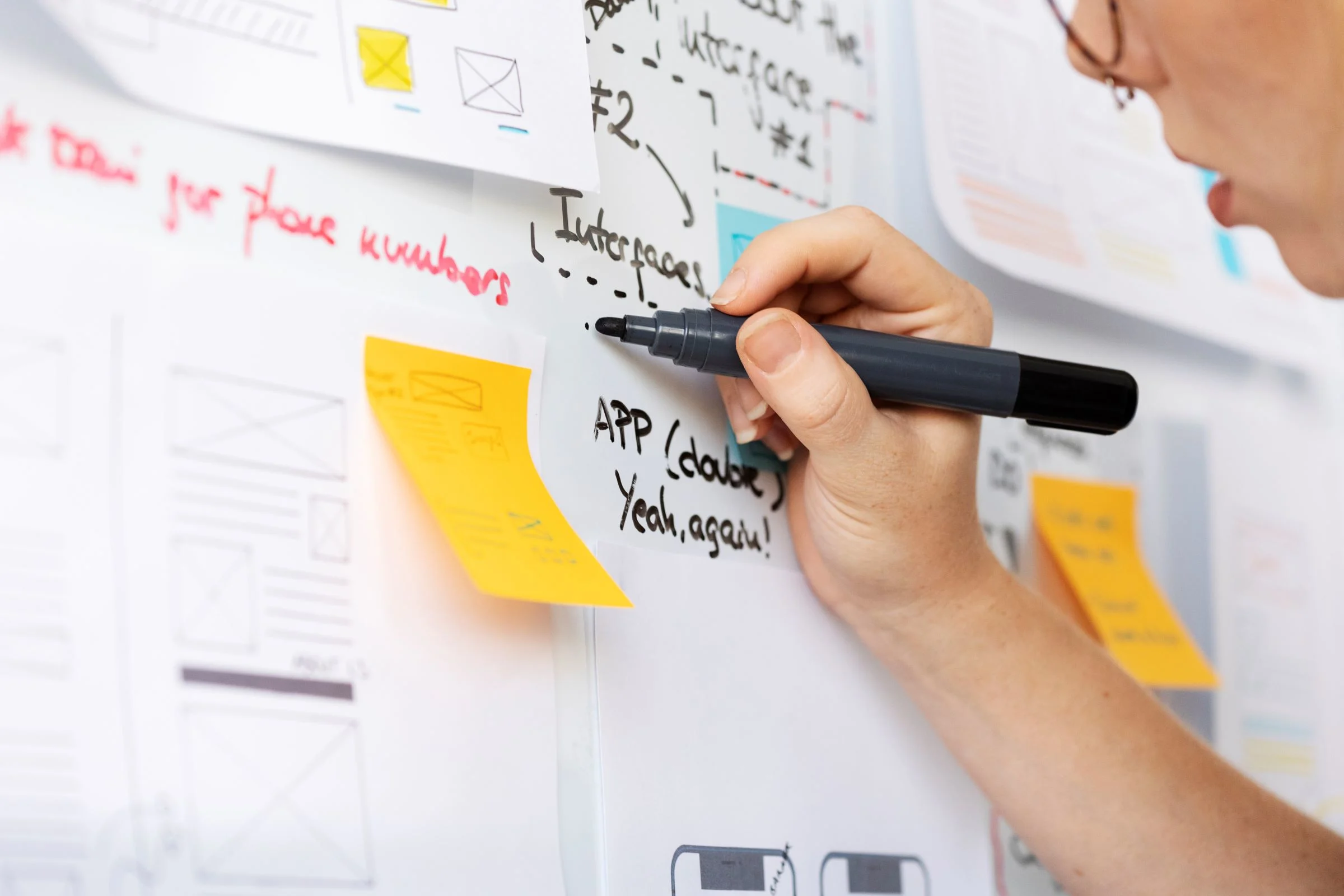Agile Working—Agile Techniques for Everyday Work, Meetings and Workshops
Definition and advantages of agile working
Advantages of agile working What makes agile work agile?
Agile time management
Task boards—a centerpiece of agile working
Agile error culture and regular agile meetings
Occasion-related, agile workshops
Customer centricity—an essential value in agile work
Working efficiently in an agile way—alone and in a team
Agility is the ability to adapt quickly to change. Agile working is increasingly on the agenda of many companies. Both employees and managers should be appropriately skilled in agile working. This includes not only techniques for individual work processes, but also the area of meetings and workshops. In this article we'll tell you how everyday work, meetings, and workshops can become more agile and what benefits this brings to you and your team.
Agile working conjures up images of colorful post-its and young start-ups with foosball tables? Yes, agile working is trendy and part of New Work. But it's not that new anymore. Meanwhile, agile thinking and agile concepts have already seeped into many areas of work. So do not panic! You probably already work agile from time to time without being aware of it. Time to change that!

Definition and advantages of agile working
But what is the exact meaning behind this term? We can define agility as the ability to adapt quickly to change. Agile work encompasses a variety of methods and techniques. The cornerstone of all agile methods is the agile manifesto. It was written in 2001 by 17 software developers in Silicon Valley. The distinction between agile values, principles, techniques and methods is also based on this manifesto. Complete agile methods are, for example, Scrum or Design Thinking. Agile techniques, on the other hand, are more small-scale. Examples of such techniques are the model of personas or the format of dailies. Agile methods provide the framework. Agile techniques are the concrete methods for implementation and these are the focus here and in our two e-trainings on the topic. // beide Trainings verlinken
But working in a more agile way initially means a change and thus additional effort in most companies. So what's the point? Let's think back to the definition. Working in an agile way enables quick adaptation to change, that is, to act quickly. And that is a real competitive advantage in our fast-moving times! Agility enables acting earlier, faster and more situationally. Another advantage of agile methods and techniques: They help to improve creativity, predictability, and team morale. They also help to reduce risks, ultimately increase quality and optimize product value.
Advantages of agile working What makes agile work agile?
Important basic principles and values of agile working are, for example, the following five aspects:
Openness to new things and a willingness to share knowledge and exchange ideas.
Commitment, i.e. the feeling of self-commitment and identification with other team members, the company and a common goal.
The concentration needed to focus all energy and attention on the ONE task or milestone you are working on.
Courage to try new things and take risks. It is important to deal constructively with mistakes afterward.
Trust and respect, both towards team members and managers and towards customers.
In addition to such an agile mindset, an agile team is an essential prerequisite for agile working. Classically, agile teams are small, collaborative units. All members are focused on speed and flexibility. They share equal responsibility and thus all contribute to the success. Regular meetings, constant exchange and iterative processes, i.e. a continuous cycle of feedback loops and improvements, help to achieve this. Examples of technical support for this include (social) intranets, collaboration tools, and messenger services. Especially with the intranet, functionality and clear structures are in the foreground. After all, information should be exchanged as efficiently as possible, independent of time zones and in some cases on a group-specific basis. Essential usage options of an intranet are therefore:
partly open, partly closed groups
the option to vote on proposals or possibilities and also to present this clearly
the ability to tag other team members and assign them tasks or ask questions directly
the option to enable push notifications
Filter and search functions are available directly in the tool

Agile time management
Agile techniques can also help plan and implement projects and tasks more accurately. One example is planning poker, a subsection of Scrum: Planning poker is useful to better estimate efforts—together as a team. To do this, each team member anonymously estimates the effort required for a project or task and writes down the time on a piece of paper. The numbers are then collected and evaluated together as a team to find a realistic benchmark. Planning poker is particularly suitable for projects with many unknown variables. At the same time, it contributes to team building.
On an individual level, another technique helps in everyday work—so-called timeboxing. Timeboxing means scheduling fixed time slots in advance for potentially open tasks—and then sticking to those limits. A simple calendar entry can help. This gives the task a clear framework. Timeboxing works best when it is planned in advance and coordinated with other tasks and fixed deadlines.

Task boards—a centerpiece of agile working
Planning is followed by implementation: In agile work, task boards are often used. They provide an overview of current tasks by visualizing them. At a glance, it becomes clear: What are the tasks? Who is responsible? By when should they be done? And above all—in which phase of processing are the individual tasks? Usually, the boards have six or four columns. Tasks are either manually or (even better) virtually attached to the board using post-its. For starters, the minimalist model with four columns is enough: Backlog, To-do, Doing and Done:
The Backlog column is for the tasks that are due at some point, but for which there is still no fixed deadline or no responsible team member.
The To-do column is for all the tasks that are due next.
The Doing column is for all tasks that are already being worked on. Here, comments are also added if waiting for a response or feedback. This speeds up the process and helps clarify dependencies.
The last column, Done, is for all the tasks that are done and ready for final review. This can be done according to the principle of "four eyes" by a colleague or by the team or project management.
It is crucial to directly enter the respective contact persons and a deadline on all cards AND to be transparent: The purpose is ultimately to ensure that all team members remain on the same level of knowledge. It also makes it clear where there are still obstacles or additional support is needed. From a simple overview, an active collaboration in an orderly flow is created.
Agile error culture and regular agile meetings
"We learn from mistakes"—this wisdom existed long before agile frameworks. But what does an agile error culture mean? And: How do mistakes not get lost in the daily work routine? In general, it is important to communicate openly and to exchange information about mistakes and misunderstandings in order to avoid them in the future. This can be done in a structured way, for example in the form of "lessons learned" meetings. Lessons learned are meetings that occur after a project is completed. Ideally, the project manager or the main person in charge organizes the meeting. All participants should take part. The following questions can serve as a guide:
What went well in this project?
What didn't work out so well yet?
What do we take away from this for next time? What do we want to keep doing, what do we want to stop doing, and what do we want to try out?
After each question, everyone has the opportunity to answer, and all answers are collected as bullet points for the respective question, summarized and recorded—and then filed for everyone to view. "Fail Fridays" is another agile meeting format. They can take place weekly or monthly, typically on Fridays. The focus is on typical mistakes, common problems and stumbling blocks. By providing employees with a safe space, mistakes can be consciously identified, corrected, and avoided in the future.
Internal meetings are primarily for regular status updates and improvements. The classic is the daily, also called stand-up. It takes place daily and usually in a standing position. This is to keep it as short and efficient as possible. For the Daily, the following questions are a good guideline:
What happened yesterday?
What is planned for today?
What are the current challenges?
Parallel to the meeting, the task board can also be expanded directly. This way, everyone is on the same page and gets in the mood for the day and the tasks.
A generally important prerequisite for agile collaboration—and collaboration in general! —is always clearly regulated communication in the form of firmly scheduled meetings AND spontaneous conversations. Quick arrangements can also be made easily and straightforwardly using pure chat programs. To some extent, this always remains a matter of taste. It is important to use already existing tools efficiently. And also to propose new tools that can be useful. This means: Keep your eyes and ears open!
Occasion-related, agile workshops
Workshops are not part of day-to-day business and therefore need to be well planned and cleverly timed. Specifically, large group workshops. As the name suggests, these are characterized by a large number of participants. This requires a suitable location and sufficient time. Examples of agile workshops include lightning talks or barcamps, also known as unconferences, ad-hoc non-conferences, or open spaces.
Lightning talks are a series of short presentations of five to ten minutes each. Depending on the number of presentations, such a workshop can then last a total of 30 to 90 minutes. The special feature of the short lectures is that the content presented is not yet completed. Thus, the workshop and the feedback from the audience provide the opportunity for adjustments and changes. At the same time, the audience is brought on board and can learn about a variety of topics. Barcamps, on the other hand, usually last much longer—at least half a day, more likely a whole day. They are comparable to a kind of "open" conference. Lecture content, speakers and results are only created through the cooperation of all participants. Still, there is a motto or title that kicks things off. Further essential components of a barcamp or open space are:
Introduction round for collecting topics.
Organizing and merging topics into 45-minute sessions.
Scheduling 15-minute breaks
Clearly marking and adhering to time windows
Collecting results and preparing them graphically
Deriving an action plan including tasks and responsible persons
Timing is always crucial for the success of agile workshops. Ideally, none of the participants involved should be in the busiest part of the year right now: This applies to sales as well as to production or accounting.
Customer centricity—an essential value in agile work
Various agile techniques enable a more customer-centric way of thinking. One example of this are personas. Personas are intended to give typical customers a face. For this purpose, the fictitious personas are given a name, age, profession, marital status and living situation, as well as hobbies. In total, there can be three to six personas. Subsequently, the team then steps into the shoes of these personas and asks themselves: What does the product or service look like from this persona's point of view? How do they assess the advantages and disadvantages? What else do they wish for?
User stories are another technique. They always refer to a scenario and very specifically to the product or service. The requirements that customers have for the product are then placed on an index card. The three essential pieces of information are value, user and function. In addition, never lose sight of the "real" customers, their feedback and their experiences. What do they like? What do they not like so much? What misunderstandings occur, and how can they be cleared up? All of this helps to design and produce better products (because they are more customer-centric).
Working efficiently in an agile way—alone and in a team
Agility is the ability to adapt quickly to change. Therefore, agile employees always keep their eyes and ears open for new things, and they dare to experiment A functioning team, an agile mindset and regular exchange are the basis for continuous improvement. Appropriate techniques for visualizing tasks, improving time management, and targeted communication round out agile work.

Learn more about agile work and which techniques can be integrated into your daily work and meeting culture in your company in our two e-trainings on agile work:
